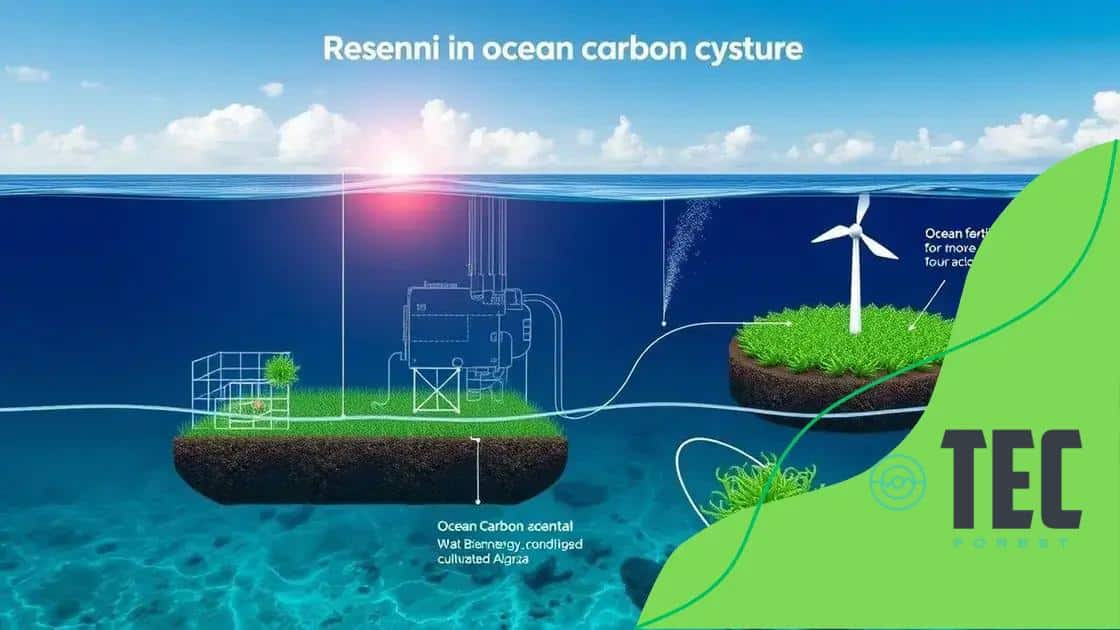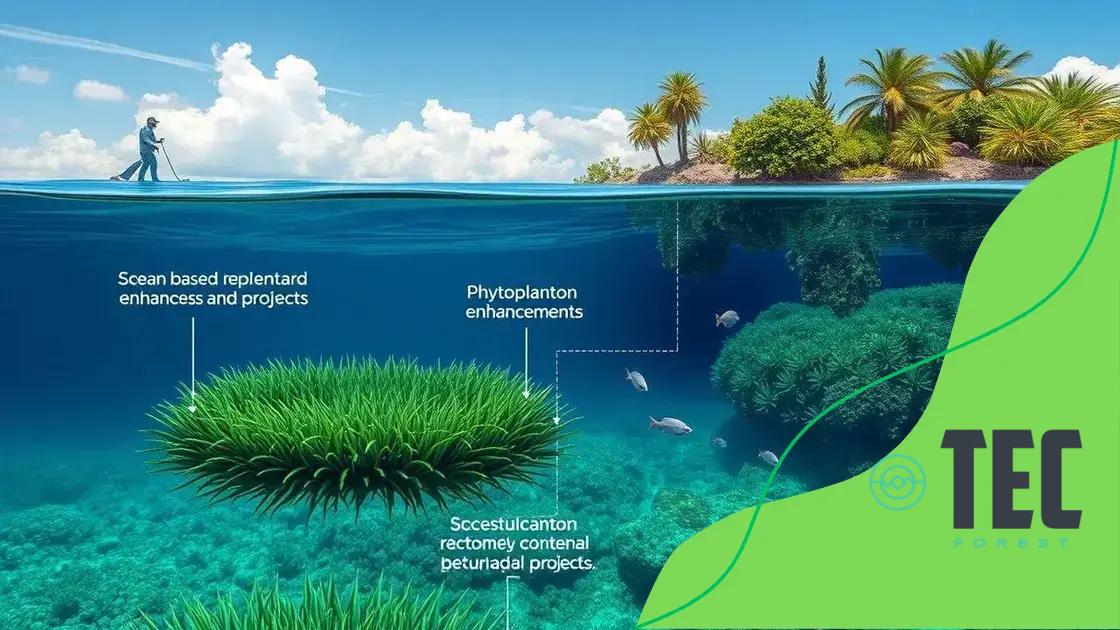Advertisement
Ocean-based carbon removal methods utilize natural ocean processes, such as phytoplankton growth and seagrass restoration, to capture and store carbon dioxide effectively, while facing regulatory and technological challenges.
Ocean-based carbon removal methods face regulatory pushback as governments navigate complex environmental policies. How might these regulations shape the future of sustainable practices? Let’s dive into the details.
Advertisement
Understanding ocean-based carbon removal
Understanding ocean-based carbon removal is crucial as we seek solutions to climate change. These methods leverage the natural processes of the ocean to capture and store carbon dioxide from the atmosphere. By examining these techniques, we can see their potential and challenges.
Key Methods of Ocean Carbon Removal
One significant approach is ocean fertilization. This method involves adding nutrients to certain parts of the ocean to stimulate phytoplankton growth. Phytoplankton are microscopic plants that absorb carbon dioxide during photosynthesis. When they die, they sink to the ocean floor, effectively sequestering carbon.
Advertisement
Seagrasses and Mangroves
Another effective strategy involves protecting and restoring coastal ecosystems like seagrasses and mangroves. These plants not only support marine life but also capture carbon in their biomass and sediments. Their preservation is vital for both carbon storage and biodiversity.
- Seagrasses can capture up to 83 million tons of carbon annually.
- Mangroves store four times more carbon per acre than tropical forests.
- Both ecosystems reduce coastal erosion and improve water quality.
- By safeguarding these habitats, we enhance their carbon storage capabilities.
Technologies are also evolving to enhance these natural processes. Innovations like direct air capture are being tested in marine environments. This technique uses machines to extract carbon dioxide directly from the air, which can then be stored or utilized in various ways. The integration of technology with these natural methods could significantly increase overall carbon capture potential.
However, ocean-based carbon removal methods face several regulatory challenges. Nations must create policies that ensure these practices are safe and environmentally sound. There is a delicate balance between innovation and ecological integrity that needs careful management. As discussions continue, it is essential to engage stakeholders to align interests and mitigate any risks.
Key technologies in ocean carbon capture

Key technologies in ocean carbon capture are vital for addressing climate change. These innovations help reduce carbon dioxide levels in the atmosphere, leveraging natural ocean processes and advanced engineering.
Direct Air Capture Systems
One notable technology is direct air capture. This method utilizes machines that extract carbon dioxide from the surrounding air. The captured carbon can then be stored underwater or utilized in various industrial processes. As these systems improve, their efficiency and scalability present exciting opportunities for reducing atmospheric CO2.
Ocean Fertilization Techniques
Another important approach involves ocean fertilization. In this technique, nutrients are added to specific ocean regions to enhance the growth of phytoplankton. This natural process can significantly absorb carbon dioxide, as phytoplankton play a crucial role in global carbon cycling. When they decompose, they transport carbon deep into the ocean, securely sequestering it.
- Enhancing phytoplankton growth can increase oceanic carbon capture.
- Focused studies are assessing the environmental impacts of nutrient addition.
- Regulations are needed to ensure safe and effective fertilization practices.
- Some methods include adding iron or nitrogen to designated ocean areas.
We also see advancements in bioenergy with carbon capture and storage (BECCS) in marine environments. This hybrid approach combines biomass energy production and carbon capture techniques. By cultivating algae and other organic materials, we can generate energy while simultaneously removing carbon dioxide from our atmosphere. The potential for large-scale implementation makes this technology noteworthy.
In addition to these methods, mineralization techniques are gaining traction. This process involves converting carbon dioxide into solid minerals that can be stored safely. Ocean minerals can bind with CO2, creating stable compounds that do not re-enter the atmosphere. These methods provide a promising route for long-term carbon storage.
As we explore these technologies, it becomes clear that collaboration among scientists, industry leaders, and policymakers is essential. They must work together to foster innovation while ensuring that implementations are environmentally sound and effective. By building a robust framework around these technologies, we can advance the fight against climate change.
Regulatory challenges facing these methods
Regulatory challenges facing ocean-based carbon removal methods are significant as these technologies advance. Policymakers must balance innovation with environmental protection to ensure sustainable practices.
Complexity of Regulations
The regulatory landscape surrounding ocean carbon removal is complex. Each region may have different legal frameworks that govern environmental protection. This can create confusion for companies trying to implement carbon removal technologies. They need to navigate a maze of local, national, and international regulations.
Environmental Impact Assessments
Before deploying ocean carbon removal methods, companies must conduct environmental impact assessments. These assessments evaluate potential ecological risks. It ensures that technologies won’t harm marine ecosystems or biodiversity. However, the assessment process can be lengthy and costly, which may delay projects.
- Compliance with environmental regulations is essential for permitting.
- Stakeholder engagement helps address concerns from local communities.
- Rigorous studies are needed to prove safety and efficiency.
- Regulatory bodies may require ongoing monitoring after implementation.
Another challenge is the lack of standardized protocols. Without clear guidelines, it becomes difficult to measure the effectiveness of carbon capture technologies. This can result in varying levels of public trust and investment. Establishing common benchmarks is essential for industry growth.
International collaboration is also critical. Many ocean-based methods cross territorial boundaries, complicating regulatory compliance. Countries must work together to create policies that support innovation while protecting the environment. Such cooperation can lead to more effective regulation and enable faster global adoption of these methods.
Ultimately, overcoming regulatory challenges requires proactive engagement from all stakeholders. Scientists, policymakers, and industry leaders must collaborate to develop frameworks that facilitate progress. A balanced approach will ensure the safe and effective implementation of ocean carbon removal technologies.
Case studies of successful implementations

Case studies of successful implementations of ocean-based carbon removal methods showcase the potential of these technologies to combat climate change. Learning from real-world examples helps illuminate the effectiveness and challenges of various approaches.
Phytoplankton Enhancement Projects
One remarkable case is the phytoplankton enhancement project off the coast of California. This initiative focused on adding iron to stimulate phytoplankton blooms. The results were impressive, as significant levels of carbon dioxide were captured in the form of biomass. This biomass eventually sank, taking carbon to the ocean depths.
Restoration of Seagrass Beds
Another inspiring example comes from the restoration of seagrass beds in the Chesapeake Bay. Restoration efforts included planting new seagrass and implementing protective measures against pollution. Over a few years, these efforts led to increased carbon sequestration and enhanced biodiversity in the area.
- Seagrass restoration can improve water quality.
- These ecosystems support marine life and protect shorelines.
- Carbon storage potential of seagrasses can reach up to 4,000 metric tons per hectare.
- Community involvement played a key role in project success.
Innovative projects utilizing ocean fertilization have also shown promise. In one study, researchers conducted a large-scale experiment in the Southern Ocean, where they added nutrients to trigger algal blooms. The results indicated a significant reduction in atmospheric carbon levels as the algae bloomed and sank.
These successful implementations highlight the importance of collaboration among scientists, businesses, and local communities. Engaging stakeholders ensures that the methods used are effective and adhere to regulations. Each case serves as a learning opportunity to refine strategies for broader applications.
While challenges remain, ongoing research and development in these areas continue to pave the way for innovative solutions. Compiling documented successes can help build public support and attract funding for future initiatives aimed at harnessing the oceans’ potential in carbon removal.
Future prospects for ocean carbon strategies
Future prospects for ocean carbon strategies present exciting possibilities. As the need for innovative climate solutions grows, the ocean can play a crucial role in capturing carbon dioxide and mitigating climate change.
Advancements in Technology
With ongoing advancements in technology, new methods for carbon removal are being developed. For example, smart sensors and artificial intelligence can optimize carbon capture in real-time. These technologies can analyze ocean conditions and adjust methods to maximize efficiency. As these tools become more accessible, they will enhance the effectiveness of current strategies.
Global Collaborations
Another important prospect involves increasing global collaboration. Countries are beginning to recognize the importance of sharing data and resources. International agreements can help facilitate the exchange of knowledge surrounding ocean carbon removal technologies. Collaborative efforts can lead to faster implementation and scaling of these methods worldwide.
- Joint research initiatives can compare different carbon capture methods.
- Shared funding can support innovative projects in developing nations.
- Collaborative policies can streamline regulatory processes.
- Global partnerships can enhance public awareness and education.
As we look ahead, biodiversity conservation becomes intertwined with carbon strategies. Protecting marine ecosystems like coral reefs and mangroves not only helps the environment but also increases the ocean’s capacity to sequester carbon. Future strategies will likely prioritize ecological health alongside carbon removal efforts, creating a more holistic approach.
Furthermore, public engagement and support will be crucial for future success. Raising awareness about ocean carbon strategies can galvanize community involvement. As more people understand the significance of these methods, support for funding and innovation will grow, allowing for more ambitious projects.
In summary, the future of ocean carbon strategies looks bright. By embracing technology, fostering global collaboration, and prioritizing biodiversity, we can enhance the potential of the ocean to contribute to climate solutions. The journey ahead will demand innovation and cooperation, but the possibilities are promising.
FAQ – Frequently Asked Questions about Ocean-Based Carbon Removal Strategies
What are ocean-based carbon removal methods?
Ocean-based carbon removal methods utilize natural processes in the ocean to capture and store carbon dioxide from the atmosphere.
How do phytoplankton contribute to carbon capture?
Phytoplankton absorb carbon dioxide during photosynthesis. When they die, they sink to the ocean floor, sequestering carbon in deep waters.
What role does technology play in enhancing carbon removal?
Advancements in technology, like smart sensors and AI, optimize carbon capture processes and improve efficiency in ocean-based methods.
Why is global collaboration important for these strategies?
Global collaboration helps share data, resources, and best practices, making it easier to implement and scale effective ocean carbon removal strategies.
